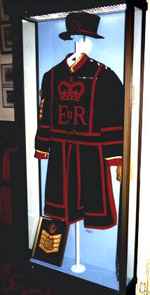The Tower of London - Yeoman Warders

Ever since the foundations of the Tower were laid in 1078, men have stood Watch and Ward over the buildings and, more importantly, the prisoners who were sent there. In the early period, the Warders would have performed their duties in plain clothes.
When Edward Seymour, Duke of Somerset was imprisoned for the first time in January 1549, he was so impressed with the diligence and cheerful bearing of the Yeoman Warders, he vowed that, if he could be freed from the Tower, he would grant them any request they desired. It was therefore fortunate that the Duke was liberated and pardoned in February 1550. The Warders held him to his promise by asking for the right to wear the same livery as members of the King's Body Guard of the Yeoman of the Guard.
As the personal Protector of the young King Edward VI, the Duke was delighted to confer this privilege of being extraordinary members of the King's closest Body Guard whose origin dated back to 1485.
Over the years, the State Dress uniform they wear has seen many alterations, the most noticeable being the change of the Monarch's initials on each side of the floral decorations. The first letter always represents the Monarch's Christian name; this is always followed by the letter 'R' meaning 'Rex' for Kings or 'Regina' for Queen.

Personnel appointed to each of the 38 established Yeoman Warders posts in the Tower of London nowadays are all retired Warrant Officers of the Army, Royal Air Force and Royal Marines. This method of recruiting was introduced by the Duke of Wellington in 1826 when he became the Constable of the Tower.
On most days, the Yeoman Warders will be seen in the Tower grounds wearing a more functional Blue Undress uniform of Victorian origin which is loosely based on the traditional design. However, for certain ceremonies and church parades, they still continue to wear their Tudor livery and carry their impressive pike-type weapons which are correctly known as 'partizans'.
As an integral part of their employment, the Warders are required to live with their families on the premises like a small village community. Those parts of the grounds which are inaccessible for visitors are their private houses.